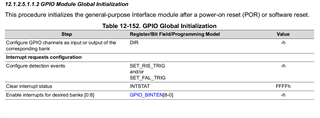Hello,
my question is how do I actually access the pins of the GPIO on the board on the TDA4AL/TDA4VM?
I have documentation on how to program a GPIO driver but it needs to be tested and I can't find any information about that.
Thanks in advance and kind regards,
Johannes
-
Ask a related question
What is a related question?A related question is a question created from another question. When the related question is created, it will be automatically linked to the original question.


